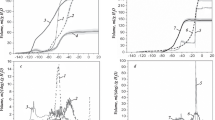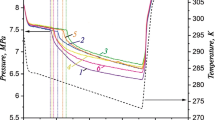This work revealed that most water‑soluble compounds have a dual nature (thermodynamic promotion or hydrate inhibition) depending on thermobaric conditions. Indeed, by lowering the melting point of ice, water‑soluble organic compounds expand the region of water‑containing liquid phase existence below 0°C. This work considered typical thermodynamic hydrate inhibitors as alcohols (methanol, ethanol, and 2‑propanol). It turned out that even methanol does not exhibit inhibitory properties below the ice crystallization line, and it does not affect the equilibrium conditions of methane hydrate formation. In this case, the observed four-phase hydrate–ice–solution–gas equilibrium either corresponds to the hydrate–ice–gas line for the water-methane system (in the case of methanol) or lies at higher temperatures (in the case of ethanol and 2‑propanol). This allowed us to assume that practically any water‑soluble organic compounds will either exhibit the properties of thermodynamic hydrate promoters in a specific temperature range below 0°C or will not affect the hydrate–ice–gas equilibrium. In addition, the presence of the ice and an aqueous liquid mixture in the system accelerates the hydrate growth (compared to the hydrate growth from the bulk phase of ice). It should also be noted that, unlike conventional thermodynamic promoters, methanol does not alter the methane hydrate’s structure and gas capacity, which is more favorable. The data obtained can contribute to developing hydrate‑based technologies for gas storage and separation of gas mixtures.



Similar content being viewed by others
References
H. M. Powell, Journal of the Chemical Society (Resumed), 61‑73 (1948).
A. Hassanpouryouzband, E. Joonaki, M. V. Farahani, et al., Chemical Society Reviews, 49, No. 15, 5225‑5309 (2020).
A. Y. Manakov and A. S. Stoporev, Russian Chemical Reviews, 90, No. 5, 566 (2021).
K. Yasuda and R. Ohmura, Journal of Chemical & Engineering Data, 53, No. 9, 2182‑2188 (2008).
R. Sun, Z. Fan, K. Li, et al., Physical Chemistry Chemical Physics, 24, No. 31, 18805‑18815 (2022).
V. P. Melnikov, A. N. Nesterov, A. M. Reshetnikov, et al., Chemical Engineering Science, 65, No. 2, 906‑914 (2010).
A. A. Sizikov and A. Y. Manakov, Fluid Phase Equilibria, 371, 75‑81 (2014).
K. Shin, I. L. Moudrakovski, C. I. Ratcliffe, et al., Angewandte Chemie, 129, No. 22, 6267‑6271 (2017).
J.‑W. Lee, and S.‑P. Kang, The Journal of Physical Chemistry B, 116, No. 1, 332‑335 (2012).
A. Semenov, R. Mendgaziev, T. Tulegenov, et al., Chemistry and Technology of Fuels and Oils, 58, No. 4, 628‑636 (2022).
S. J. Henderson and R. J. Speedy, Journal of Physical Chemistry, 91, No. 11, 3069‑3072 (1987).
F. V. Zhurko, A. Y. Manakov, and V. I. Kosyakov, Chemical Engineering Science, 65, No. 2, 900‑905 (2010).
A. Dougherty, Z. Bartholet, K. Chumsky, et al., Journal of Geophysical Research: Planets, 123, No. 12, 3080‑3087 (2018).
A. Potts and D. Davidson, the Journal of Physical Chemistry, 69, No. 3, 996‑1000 (1965).
M. S. Wahl, A. Adasen, D. R. Helmet, et al., Fluid Phase Equilibria, 522, 112741 (2020).
A. P. Semenov, R. I. Mendgaziev, A. S. Stoporev, et al., Chemical Engineering Journal, 423, 130227 (2021).
A. P. Semenov, A. S. Stoporev, R. I. Mendgaziev, et al., Journal of Chemical Thermodynamics, 137, 119‑130 (2019).
S. Muromachi, T. Abe, T. Maekawa, et al., Fluid Phase Equilibria, 398, 1‑4 (2015).
Y. Gong, R. I. Mendgaziev, W. Hu, et al., Chemical Engineering Journal, 429, 132386 (2022).
M. Lauricella, M. R. Ghaani, P. K. Nandi, et al., The Journal of Physical Chemistry C, 126, No. 13, 6075‑6081 (2022).
J. S. Pandey, S. Khan, and N. von Solms, Energies, 15, No. 18, 6814 (2022).
Author information
Authors and Affiliations
Corresponding author
Additional information
Translated from Khimiya i Tekhnologiya Topliv i Masel, No. 6, pp. 44–48 November – December, 2022.
Rights and permissions
Springer Nature or its licensor (e.g. a society or other partner) holds exclusive rights to this article under a publishing agreement with the author(s) or other rightsholder(s); author self-archiving of the accepted manuscript version of this article is solely governed by the terms of such publishing agreement and applicable law.
About this article
Cite this article
Yarakhmedov, M.B., Semenov, A.P. & Stoporev, A.S. Effect of Lower Alcohols on the Formation of Methane Hydrate at Temperatures Below the Ice Melting Point. Chem Technol Fuels Oils 58, 962–966 (2023). https://doi.org/10.1007/s10553-023-01476-x
Published:
Issue Date:
DOI: https://doi.org/10.1007/s10553-023-01476-x




